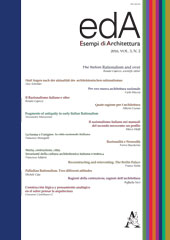Estratto da
ESEMPI DI ARCHITETTURA
International Journal of Architecture and Engineering
Palladian rationalism two different attitudes
ESEMPI DI ARCHITETTURA
International Journal of Architecture and Engineering
Palladian rationalism two different attitudes

The relationship between formal autonomy and historical references is here considered from the typologicalperspective and the concept of permanence. That permanent facts have a direct impact on theurban form is shown by historical buildings that can accommodate over time different uses and destinations,while maintaining their shape. But which can also, through their type-morphological form,result in time as reference models for the contemporary project.This principle of permanence with respect to historical events takes place thanks to their capacity forresistance, to the concreteness of their architectural presence, to the persistence within the changingcity. A concreteness that cannot be reduced to abstract schemes, but that endures over time in its architecturalphysicality.As case study are here considered some works by Andrea Palladio as examples of reference both forhistorical-critical analysis and for the architectural design. These concrete architectures, most of themstill permanent inside the city, are here considered as rationalist exempla to be investigated on a dualnotion of form. Architectures that are still exemplary today, in the rationality of their forms, both asreference models for the project, and as objects of analytical studies aimed to reveal their underlyingcompositive principles.Through these emerge so two different ways of intending formal attitude in relation to historical references:a realist one, defined by the typo-morphological Italian school of the Sixties and translated insome projects, for example, by Aldo Rossi and Giorgio Grassi. And a more analytical one followed bythe Anglo-American school, going back by the iconological approach of the Warburg studies, representedin architectural field by a triad of historians and designers, like Wittkower-Rowe-Eisenman.
| pagine: | 69-76 |
| DOI: | 10.4399/978885489918611 |
| data pubblicazione: | Dicembre 2016 |
| editore: | Aracne |








